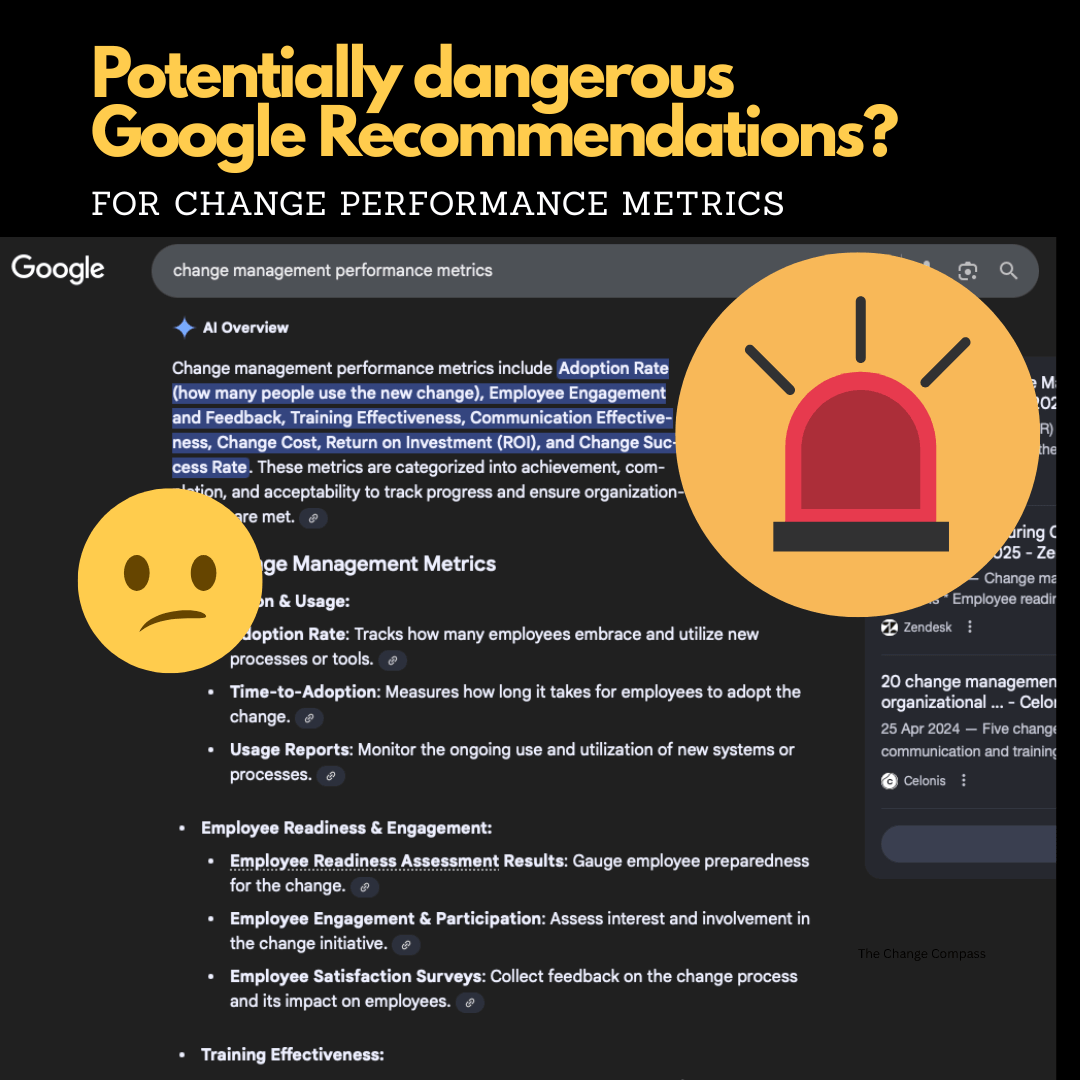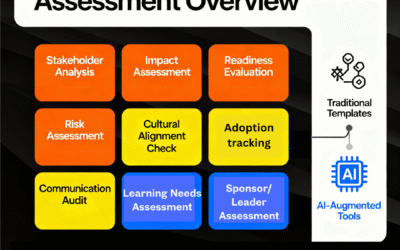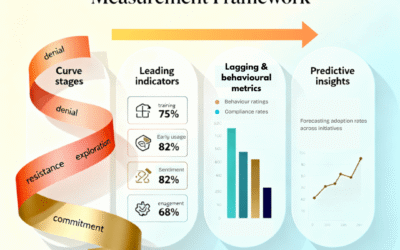Performance metrics are the compass that guides change practitioners through complex transformation initiatives. Yet despite their critical importance, many organisations unknowingly employ flawed metrics that provide misleading insights and potentially sabotage their change efforts. A closer look reveals some of the danger of conventional change management performance metrics and offers a strategic approach to measurement that truly drives success.
In fact, a quick Google search revealed a list of recommended change management performance metrics. However, some of these are potentially dangerous to incorporate without a closer understanding of the type of change being implemented, the change environment, stakeholder needs and overall change approach required. Let’s go through some of these ‘hidden dangers’ in this article.
The Measurement Imperative in Change Management
Change management has long been criticised as being too “soft” to measure effectively. This perception persists despite overwhelming evidence that data-driven approaches significantly enhance change outcomes. Research consistently demonstrates that organisations measuring change management performance are more likely to meet or exceed project objectives.
The resistance to measurement often stems from change practitioners’ preference for people-focused approaches over numerical analysis. In today’s data-rich environment, where artificial intelligence and predictive analytics are reshaping business operations, change management must embrace measurement to remain relevant and demonstrate value.
Modern organisations rely on data across all functions – from finance and operations to risk management and procurement. Without data, these departments cannot function effectively or determine whether they are achieving their targets. The same principle applies to change management: effective measurement enables practitioners to track progress, identify issues early, and make informed adjustments to their strategies.
The Problem with Traditional Adoption and Usage Metrics
Adoption and usage represent the ultimate goal of any change initiative, yet this seemingly straightforward metric harbours significant complexities. Most organisations measure adoption superficially—tracking whether people are using new systems or processes without examining the quality or effectiveness of that usage.
True adoption requires achieving full benefit realisation, which depends on several interconnected outcomes:
• Accurate impact assessment that understands how change affects specific stakeholder groups
• Effective engagement strategies tailored to different audiences
• Continuous tracking and reinforcement mechanisms
• Clear definition of required behaviours for success
Generic change approaches might achieve some adoption at best, but to get full adoption there is a series of outcomes you need to have achieved. The behaviours need to be clear, specific and actionable, yet many organisations fail to establish these precise behavioural indicators.
Furthermore, adoption measurements often ignore the temporal dimension. Early adoption rates may appear promising, but without sustained reinforcement and measurement, initial enthusiasm frequently wanes. Effective adoption metrics must track behaviour change over extended periods and identify the specific interventions needed to maintain momentum.
Employee Readiness and Engagement: Beyond Surface-Level Satisfaction
Employee readiness and engagement form the cornerstone of successful change initiatives, yet these areas suffer from widespread measurement inadequacies. Most change practitioners focus extensively on these metrics, but their approaches often lack the sophistication required for meaningful insights.
The Critical Role of Impact Assessment
Accurate impact assessment serves as the foundation for effective readiness and engagement measurement. Any inaccuracy in understanding how change affects specific stakeholder groups inevitably leads to insufficient preparation and engagement strategies. This fundamental flaw cascades through the entire change process, undermining subsequent measurement efforts.
Impact assessment requires deep analysis of how change affects different roles, departments, and individual circumstances. Generic assessments fail to capture these nuances, leading to one-size-fits-all engagement strategies that satisfy no one effectively.
Participation Versus Meaningful Involvement
Employee participation metrics suffer from significant limitations related to change type and context. The key lies in measuring relevant participation rather than absolute participation rates:
For compliance-driven changes:
• Focus on communication effectiveness and readiness preparation
• Track understanding levels and procedure adherence
• Monitor feedback on implementation challenges
For transformational changes:
• Emphasise co-creation opportunities and stakeholder input
• Measure feedback integration and stakeholder influence on change design
• Track collaborative problem-solving activities
Maximum participation might seem desirable, but the nature of the change determines appropriate participation levels. Significant restructuring initiatives or regulatory compliance changes naturally limit meaningful participation opportunities compared to voluntary improvement projects.
The Satisfaction Survey Trap
Employee satisfaction surveys present particular challenges for change measurement. The purpose of satisfaction surveys requires careful definition:
• Are you seeking feedback on training content quality?
• Is the focus on communication channels effectiveness?
• Are you measuring leadership session impact?
• Do you want to assess overall transformation experience?
Without specific focus, satisfaction surveys generate ambiguous data that provides limited actionable insight. More problematically, satisfaction may not align with change necessity. Employees might express dissatisfaction with change approaches that are nonetheless essential for regulatory compliance or competitive survival. In these situations, satisfaction becomes irrelevant, and measurement should focus on understanding effectiveness and identifying improvement opportunities within necessary constraints.
Training and Communication: Moving Beyond Binary Effectiveness
Training and communication effectiveness represent the most commonly measured aspects of change management, yet this narrow focus creates dangerous blind spots. Whilst these elements are undoubtedly important delivery vehicles, they represent only partial components of comprehensive change strategies.
The Capability Development Ecosystem
Training effectiveness measurement often conflates learning with capability development. Effective capability building requires diverse interventions beyond traditional training:
• Coaching and personalised support sessions
• Structured feedback mechanisms
• Sandbox practice environments for skill development
• Team discussions and peer learning opportunities
• Mentoring relationships and knowledge transfer
Modern capability development leverages technology-enhanced approaches that traditional training metrics fail to capture:
• Gamified content delivery and interactive learning modules
• Micro-learning sequences and just-in-time training
• Multimedia integration with videos, simulations, and virtual reality
• Avatar-based instruction and AI-powered tutoring systems
• Adaptive learning pathways that personalise content delivery
Measuring effectiveness in these environments requires sophisticated metrics that track engagement, retention, application, and long-term behaviour change across multiple learning modalities.
Communication Beyond Hit Rates
Communication effectiveness measurement typically focuses on reach metrics—how many people viewed content or attended sessions. These “hit rate” measurements provide limited insight into actual communication effectiveness, which depends on:
• Comprehension levels and message clarity
• Information retention and recall accuracy
• Perceived relevance to individual roles
• Action generation and behaviour change
Advanced communication measurement utilises sophisticated analytics available through modern platforms:
Microsoft Viva Engage and Teams Analytics:
• User engagement patterns and interaction frequency
• Device usage behaviours across different communication channels
• Community reach statistics and network analysis
• Conversation quality indicators and response rates
A/B Testing Methodologies:
• Test different messages or formats with smaller audience segments
• Identify the most effective approaches before broader deployment
• Transform communication from educated guesswork into data-driven optimisation
• Measure conversion rates and action completion across message variants
Financial Performance: Beyond Cost-Focused ROI
Financial metrics in change management suffer from fundamental conceptual limitations that undermine their utility for strategic decision-making. The predominant focus on return on investment (ROI) and cost management treats change as an expense rather than a value creation opportunity.
Traditional ROI calculations examine financial benefits of change management spending against change outcomes. Whilst this approach provides some insight, it fundamentally limits change management to a cost-minimisation function rather than recognising its potential for:
• Enhanced organisational agility and adaptability
• Improved employee engagement and retention rates
• Reduced future change resistance and implementation time
• Accelerated innovation adoption and competitive positioning
• Strengthened stakeholder relationships and trust building
More sophisticated financial measurement approaches assess change management’s contribution to organisational capability building, risk mitigation, and strategic option creation. These broader value considerations provide more accurate assessment of change management’s true organisational impact.
The Resistance Metrics Minefield
Resistance metrics represent perhaps the most problematic area in change management measurement. The conventional approach of monitoring resistance levels and aiming for minimal resistance creates dangerous dynamics that undermine change effectiveness.
Resistance monitoring often leads to labelling stakeholders as “resistant” and focusing efforts on reducing negative feedback. This approach fundamentally misunderstands resistance as a natural and potentially valuable component of change processes.
Transforming Resistance into Feedback
Rather than minimising resistance, effective change management should encourage comprehensive feedback from all stakeholder groups. The goal shifts from resistance reduction to feedback optimisation:
Feedback Quality Indicators:
• Specificity of concerns raised and solutions suggested
• Constructive nature of criticism and improvement ideas
• Stakeholder willingness to engage in problem-solving discussions
• Implementation feasibility of suggested modifications
Implementation Tracking:
• Percentage of feedback items addressed in change plans
• Time from feedback receipt to response or action
• Stakeholder perception of influence on change processes
• Communication quality regarding feedback disposition
Effective resistance can highlight legitimate concerns, identify implementation risks, and strengthen final solutions through stakeholder input. The question becomes: What specific aspects of change generate concern, and how can legitimate resistance improve change outcomes?
Compliance and Adherence: The Missing Reinforcement Link
Compliance and adherence metrics represent critical but often overlooked components of change measurement. These metrics assess how effectively employees follow new policies and procedures—the ultimate test of change success.
The challenge lies in measurement timing and responsibility allocation:
Common Gaps:
• Change teams fail to design compliance measurement into their change processes
• Assessment is left for post-implementation periods when project teams have moved on
• Timing gaps create measurement blind spots precisely when reinforcement is most critical
• Lack of clear ownership for ongoing compliance monitoring
Effective Measurement Approaches:
• Digital systems providing automated compliance tracking
• Leadership follow-up protocols and structured audit processes
• Operational integration rather than separate evaluation activities
• Real-time dashboards showing compliance trends and exceptions
The key is embedding measurement into operational processes rather than treating it as a separate evaluation activity. This integration ensures continuous monitoring and rapid identification of compliance issues before they become systemic problems.
Establishing Effective Change Management Metrics
Developing effective change management metrics requires systematic approach that addresses the limitations of traditional measurement while leveraging modern technological capabilities.
The Three-Level Performance Framework
Leading organisations utilise comprehensive measurement frameworks that address multiple performance levels simultaneously:
Change Management Performance:
• Completion of change management plans and milestone delivery
• Activation of core roles like sponsors and change champions
• Progress against planned activities and timeline adherence
• Quality of change management deliverables and stakeholder feedback
Individual Performance (using frameworks like ADKAR):
• Awareness levels and understanding of change rationale
• Desire for change and motivation to participate
• Knowledge acquisition through training and communication
• Ability to implement required behaviours and skills
• Reinforcement mechanisms and behaviour sustainability
Organisational Performance:
• Achievement of intended business outcomes and strategic objectives
• Financial performance improvements and cost reductions
• Operational efficiency gains and process improvements
• Customer satisfaction improvements and market position
This approach recognises the interdependent nature of change success across organisational, individual, and change management performance dimensions.
Leveraging Modern Technology for Enhanced Measurement
Contemporary change management measurement can exploit advanced technologies that were unavailable to previous generations of practitioners:
AI-Powered Analytics:
• Sentiment analysis processing large volumes of text feedback
• Pattern detection identifying predictive indicators of change success
• Automated insights generation from multiple data sources
• Real-time risk assessment and early warning systems
Predictive Capabilities:
• Forecasting change outcomes based on early indicators
• Proactive intervention before problems become critical
• Historical pattern analysis for correlation identification
• Capacity planning and resource optimisation
Real-Time Monitoring:
• Continuous dashboards and automated reporting systems
• Immediate identification of emerging issues
• Rapid response to developing challenges
• Data-driven optimisation throughout change processes
Building Measurement Into Change Strategy
Effective change measurement requires integration into change strategy from the earliest planning stages rather than being added as an afterthought. This integration ensures measurement serves strategic purposes rather than merely satisfying reporting requirements.
Defining Success Before Beginning
Successful change measurement begins with clear definition of desired outcomes and success criteria:
Primary Sponsor Requirements:
• Articulate specific, measurable objectives aligned with organisational benefits
• Connect change outcomes to strategic goals and performance indicators
• Define acceptable risk levels and tolerance thresholds
• Establish timeline expectations and milestone definitions
Stakeholder Engagement:
• Include leaders, subject matter experts, and project managers in success definition
• Ensure shared understanding across all stakeholder groups
• Align measurement focus on outcomes that matter to everyone
• Avoid narrow technical achievements without business relevance
Selecting Appropriate Metrics for Context
Different types of change require different measurement approaches:
Regulatory Compliance Changes:
• Focus on adherence rates and audit readiness
• Track training completion and competency verification
• Monitor risk mitigation and control effectiveness
• Measure timeline compliance and regulatory approval
Cultural Transformation Initiatives:
• Emphasise behaviour change and value demonstration
• Track engagement levels and participation quality
• Monitor leadership modelling and reinforcement
• Measure employee sentiment and satisfaction trends
Technology Implementation Projects:
• Focus on system usage rates and functionality adoption
• Track user proficiency and support requirement reduction
• Monitor performance improvements and efficiency gains
• Measure integration success and data quality
Measurement complexity should align with change complexity and organisational capability. Simple changes in mature organisations might require only basic metrics, whilst complex transformations in change-inexperienced organisations demand comprehensive measurement frameworks.
Future Directions in Change Management Measurement
The future of change management measurement lies in sophisticated integration of human insight with technological capability. Several key trends are reshaping measurement approaches:
Predictive Change Management:
• Historical data enables forecasting of change outcomes
• Proactive optimisation of change approaches before issues arise
• Real-time adjustment based on predictive indicators
• Continuous learning from measurement data across initiatives
Integrated Organisational Systems:
• Connection to broader business performance metrics
• Direct demonstration of change impact on customer satisfaction
• Integration with financial and operational reporting systems
• Holistic view of organisational health and capability
Continuous Change Capability:
• Measurement of organisational change capacity and resilience
• Tracking of adaptation speed and learning effectiveness
• Building change capability as core organisational competency
• Supporting ongoing transformation rather than discrete projects
The evolution toward continuous change requires measurement systems that support ongoing transformation rather than discrete project evaluation. These systems must track organisational change capability, adaptation speed, and resilience development as essential business capabilities.
Measuring What Matters
Change management performance metrics represent both opportunity and risk for organisations pursuing transformation. Traditional measurement approaches harbour significant limitations that can mislead practitioners and undermine change success. However, sophisticated measurement systems that leverage modern technology and address these limitations can dramatically enhance change effectiveness.
The path forward requires abandoning simplistic metrics that provide false comfort in favour of comprehensive measurement frameworks that capture the complexity of organisational change. Key principles for effective measurement include:
Strategic Focus:
• Serve genuine business purposes rather than administrative requirements
• Enable better decisions and drive continuous improvement
• Demonstrate measurable value of professional change management
• Connect change outcomes to organisational success metrics
Technological Integration:
• Leverage AI and machine learning for enhanced analytical precision
• Utilise real-time monitoring and predictive capabilities
• Integrate with broader organisational data systems
• Automate routine measurement while preserving human insight
Comprehensive Approach:
• Address multiple performance levels simultaneously
• Balance quantitative metrics with qualitative insights
• Include temporal dimensions and sustainability factors
• Measure capability building alongside immediate outcomes
Most importantly, effective change measurement must serve strategic purposes rather than administrative requirements. Metrics should enable better decisions, drive continuous improvement, and demonstrate the value that professional change management brings to organisational success.
The organisations that master sophisticated change measurement will possess significant competitive advantages in an era of accelerating change. They will anticipate challenges before they emerge, optimise interventions in real-time, and build organisational capabilities that enable sustained transformation success. The question is not whether to measure change management performance, but whether to measure it effectively enough to create lasting competitive advantage.





